Digital Posters
Spine & Nervous System Imaging
ISMRM & SMRT Annual Meeting • 15-20 May 2021

| Concurrent 5 | 19:00 - 20:00 |
3441.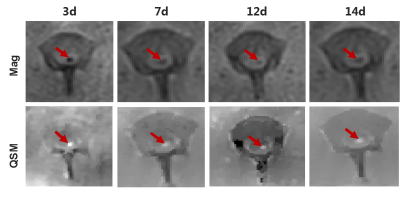 |
Application of QSM in SPIO - labeled stem cell transplantation in Beagles with acute spinal cord injury
Junting Zou1, Jilei Zhang2, Zhao Xiance2, Yuanyuan Xie1, Bing Zhang1, and Xiaoli Mai1
1Nanjing Drum Tower Hospital, Nanjing, China, 2Philips Healthcare, Shanghai, China
Tracing and monitoring the growth of transplanted stem cells in vivo has become a focus of research. The purpose of this study is to realize the dynamic tracing of transplanted mesenchymal stem cells labeled with nano-iron(SPIO-huc-MSCs), and preliminarily explore the feasibility of indirect tracing of SPIO-huc-MSCs by QSM technology. The results show that susceptibility values in the areas containing iron are significantly different from those in the normal spinal cord, which indicates that the iron concentration in the injured area decreases gradually. By quantifying iron concentration, QSM technology can be used to dynamically trace SPIO labeled stem cells in vivo.
|
|||
3442.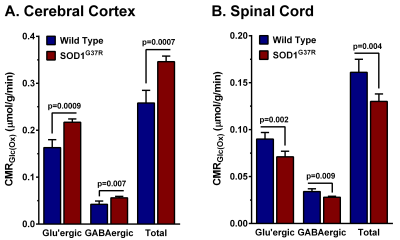 |
Neurometabolic Analysis in Amyotrophic Lateral Sclerosis: A 1H-[13C]-NMR investigation
Dipak Roy1 and Anant Bahadur Patel1
1NMR Microimaging and Spectroscopy Facility, Centre for Cellular and Molecular Biology, Hyderabad, India
In this study we have evaluated the neurometabolic activity of a transgenic (SOD1G37R) mouse model of ALS by 1H-[13C]-NMR spectroscopy together with an infusion of 13C labeled substrates (glucose/acetate). Reduced motor performance and abnormal gait were observed in 18-month old male SOD1G37R mice. The glutamatergic and GABAergic neurometabolic rates were decreased, while astroglial metabolic flux was increased in the spinal cord of the SOD1G37R mice. In contrast, neuronal and astroglial metabolic activities were increased in the cerebral cortex of these mice.
|
|||
3443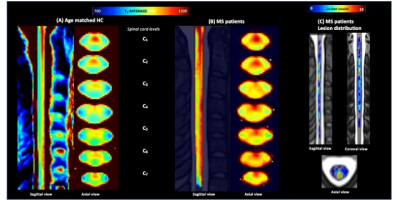 |
3D-MP2RAGE T1 mapping to characterize regional cervical spinal cord impairments in ALS and MS patients. Video Permission Withheld
Samira Mchinda1,2, Sarah Demortière3, Henitsoa Rasoanandrianina4, Claire Costes1,2, Jean Pelletier2,5, Shahram Attarian6, Aude-Marie Grapperon6, Bertrand Audoin2,5, Annie Vershueren6, and Virginie Callot1,2
1Aix-Marseille Univ, CNRS, CRMBM, Marseille, France, 2APHM, Hôpital Universitaire Timone, CEMEREM, Marseille, France, 3APHM, Hôpital Universitaire Timone, Neurology Department, Marseille, France, 4Departement of Research and Innovation, Olea Medical, La Ciotat, France, 5. APHM, Hôpital Universitaire Timone, Neurology Department, Marseille, France, 6APHM, Hôpital Universitaire Timone, Reference Center for Neuromuscular Disorders and ALS, Marseille, France
The MP2RAGE sequence has never been applied for T1 quantification in the context of neurodegenerative spinal cord pathologies. In this study, the technique demonstrated good discrimination between WM and GM in healthy controls, better detection of cervical lesions in Multiple Sclerosis patients, and increased T1 values in corticospinal tracts of both Amyotrophic Lateral Sclerosis patients and MS patients , and lateral sensory tracts of MS patients. Very robust and compatible with clinical scan time, the MP2RAGE may be a technique of choice for longitudinal studies.
|
|||
3444.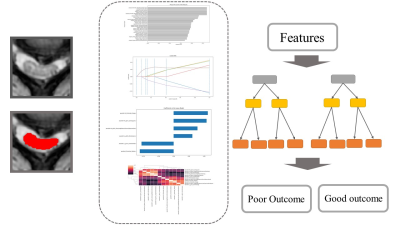 |
Interpreting a machine learning model: radiomics in cervical spondylotic myelopathy postoperative recovery prediction
Mengze Zhang1, Hanqiang Ouyang1, Dan Jing1, Jiangfang Liu1, Chunjie Wang1, Huishu Yuan1, and Liang Jiang1
1Peking University Third Hospital, Beijing, China
Previous studies have confirmed that conventional MRI parameters lack stability, and the evaluation of the prognosis of CSM sometimes is controversial. In our study, we first introduced radiomics, a quantitative analysis of image features, into the study of CSM and obtained a reliable and stable model. By analysis features' importance and unboxing the extremely randomized trees model, we came up with assumptions of the relationship between specific features and post-surgical recovery prediction.
|
|||
3445.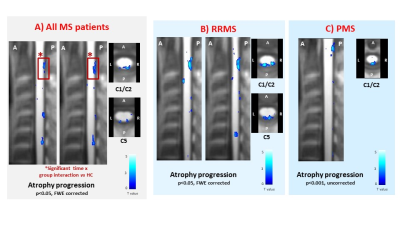 |
Characterizing 1-Year Development of Cervical Cord Atrophy Across Different MS Phenotypes: A Voxel-Wise, Multicenter Analysis
Paola Valsasina1, Maria A. Rocca1,2,3, Claudio Gobbi4,5, Chiara Zecca4,5, Alex Rovira6, Xavier Montalban7, Hugh Kearney8, Olga Ciccarelli8, Lucy Matthews9, Jacqueline Palace9, Antonio Gallo10, Alvino Bisecco10, Achim Gass11,
Philipp Eisele11, and Massimo Filippi1,2,3,12,13
1Neuroimaging Research Unit, Division of Neuroscience, IRCCS San Raffaele Scientific Institute, Milan, Italy, 2Neurology Unit, IRCCS San Raffaele Scientific Institute, Milan, Italy, 3Vita-Salute San Raffaele University, Milan, Italy, 4Multiple Sclerosis Center, Department of Neurology, Neurocenter of Southern Switzerland, Civic Hospital, Lugano, Switzerland, 5Faculty of Biomedical Sciences, Università della Svizzera Italiana, Lugano, Switzerland, 6Section of Neuroradiology, Department of Radiology, Hospital Universitari Vall d’Hebron, Barcelona, Spain, 7Department of Neurology/Neuroimmunology, Multiple Sclerosis Center of Catalonia, Hospital Universitari Vall d’Hebron, Barcelona, Spain, 8NMR Research Unit, Queen Square MS Centre, Department of Neuroinflammation, UCL Institute of Neurology, London, United Kingdom, 9Nuffield Department of Clinical Neurosciences, University of Oxford, Oxford, United Kingdom, 10Department of Advanced Medical and Surgical Sciences, and 3T MRI Center, University of Campania “Luigi Vanvitelli”, Naples, Italy, 11Department of Neurology, Universitätsmedizin Mannheim, University of Heidelberg, Mannheim, Germany, 12Neurorehabilitation Unit, IRCCS San Raffaele Scientific Institute, Milan, Italy, 13Neurophysiology Service, IRCCS San Raffaele Scientific Institute, Milan, Italy
Here, we used a longitudinal, voxel-wise analysis to characterize baseline cervical cord tissue loss and its progression over 1-year follow-up in a cohort of patients with multiple sclerosis (MS) acquired at 7 European sites. Results indicated that baseline cord atrophy was severe in MS patients vs controls, with a prevalent involvement of posterior/lateral regions of the upper cord, a differential effect across phenotypes and a strong correlation with disability. Cord atrophy significantly increased over time in all MS patients, was more widespread in relapsing-remitting MS than in other phenotypes and contributed to explain clinical disability at 1-year follow-up.
|
|||
3446.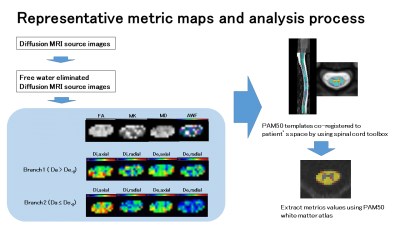 |
Free Water Eliminated White Matter Tract Integrity of Spinal Cord in Multiple Sclerosis and Neuromyelitis Optica Spectrum Disorder
Masaaki Hori1,2, Kouhei Kamiya1,2, Akifumi Hagiwara2,3, Kazumasa Yokoyama4, Issei Fukunaga5, Katsuhiro Sano2, Koji Kamagata2, Katsutoshi Murata6, Shohei Fujita2, Christina Andica2, Akihiko Wada2, Julien Cohen-Adad7, and Shigeki Aoki2
1Radiology, Toho University Omori Medical Center, Tokyo, Japan, 2Radiology, Juntendo University School of Medicine, Tokyo, Japan, 3Radiology, David Geffen School of Medicine, Los Angeles, CA, United States, 4Neurology, Juntendo University School of Medicine, Tokyo, Japan, 5Juntendo University School of Medicine, Tokyo, Japan, 6Siemens Japan K.K, Tokyo, Japan, 7NeuroPoly Lab, Polytechnique Montreal, Montréal, QC, Canada
We investigated free water eliminated kurtosis-based white matter tract integrity to distinguish microstructural changes in the spinal cords of patients with MS and Neuromyelitis Optica. FA was significant higher in spinal cord white matter in MS (P=0.0025). There was no significant difference in other diffusion model-based metrics. The values of FA seem to be non-specific but robust. Therefore, clinical feasible and more optimized diffusion microstructural models and data acquisitions for spinal cord may be needed to provide an additional information and to be biomarker in patients with MS and NMOSD in vivo.
|
|||
3447.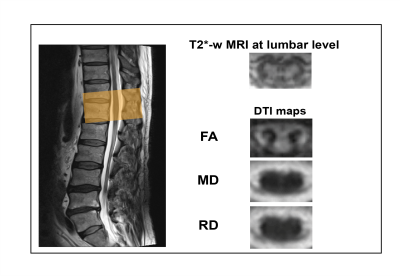 |
Spinal cord neurodegeneration rostral and caudal to a degenerative cervical myelopathy (DCM): a quantitative MRI study
Kevin Vallotton1, Gergely David1, Armin Curt1, Michael Fehlings2, Claudia A. M. Gandini Wheeler-Kingshott3,4,5, Rebecca S. Samson6, Julien Cohen-Adad7, Muhammad Ali Akbar2, Patrick Freund1,8,9, and Maryam Seif1
1Spinal Cord Injury Center, University Hospital Balgrist, University of Zurich, Zurich, Switzerland, Zuerich, Switzerland, 2University of Toronto Spine Program and Toronto Western Hospital, Toronto, Ontario, Canada, Toronto, ON, Canada, 3NMR Research Unit, Queen Square MS Centre, Department of Neuroinflammation, UCL Queen Square Institute of Neurology, Faculty of Brain Sciences, University College London (UCL), London, United Kingdom, 4Department of Brain and Behavioural Sciences, University of Pavia, Pavia, Italy, Pavia, Italy, 5Brain Connectivity Center Research Department, IRCCS Mondino Foundation, Pavia, Italy, 6Queen Square MS Centre, UCL Queen Square Institute of Neurology, Faculty of Brain Sciences, London, United Kingdom, London, United Kingdom, 7Functional Neuroimaging Unit, CRIUGM, University of Montreal, Montreal, QC, Canada, Montreal, QC, Canada, 8Department of Neurophysics, Max Planck Institute for Human Cognitive and Brain Sciences, Leipzig, Germany, 9Wellcome Trust Centre for Neuroimaging, UCL Institute of Neurology, London, United Kingdom
Evidence suggests that degenerative cervical myelopathy (DCM) induces neurodegeneration along the entire spinal cord, i.e. rostral and caudal to the compression level. To investigate macro- and microstructural changes along the spinal cord, we applied high-resolution T2*- and diffusion-weighted MRI at both cervical and lumbar cord levels in mild to moderate DCM patients and healthy controls. This study shows that tissue-specific spinal cord neurodegeneration is evident rostral and caudal to the compression site in DCM with mild or moderate symptoms and that the extent of cervical and lumbar cord atrophy is similar.
|
|||
3448.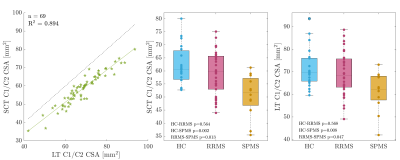 |
Feasibility of cervical spinal cord cross-sectional measurements from 3D T1w sagittal head MRI at 7T
Vanessa Wiggermann1, Henrik Lundell1, Mads Alexander Just Madsen1, Christopher Fugl Madelung1, and Hartwig Roman Siebner1,2,3
1Danish Research Centre for Magnetic Resonance, Centre for Functional and Diagnostic Imaging and Research, Copenhagen University Hospital Hvidovre, Hvidovre, Denmark, 2Dept. of Neurology, Copenhagen University Hospital Bispebjerg, Copenhagen, Denmark, 3Institute for Clinical Medicine, Faculty of Medical and Health Sciences, University of Copenhagen, Copenhagen, Denmark
Spinal cord atrophy is a highly relevant measure of disease progression in multiple sclerosis. Here, we assessed whether cord area measurements from head MRI scans at 7T are feasible with semi- and fully-automated tools. Although different tools can yield systematically different absolute cord areas, measurements were highly consistent within studies as well as across field strengths, if images with similar voxel sizes were used. At higher spatial resolution, the volume of partial signal voxels is reduced and smaller cord areas and diameters were measured than typically reported in literature.
|
|||
3449.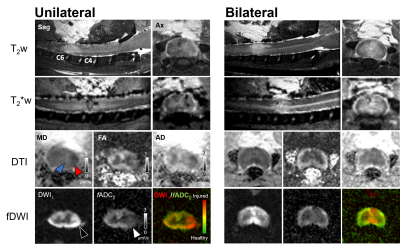 |
Quantitative Magnetic Resonance Imaging Assessment of Cervical Spinal Cord Injury in Rats
Seung Yi Lee1, Shekar Kurpad2, and Matthew Budde2
1Biophysics, Medical College of Wisconsin, Milwaukee, WI, United States, 2Neurosurgery, Medical College of Wisconsin, Milwaukee, WI, United States
This work aims to investigate the relationship neurological outcomes from a cervical contusion spinal cord injury model in rats with early MRI markers including edema, hemorrhage, and diffusion weighted imaging. A rat-specific MRI template was constructed from a histological atlas to permit inter-subject registration. Compared to diffusion tensor imaging (DTI) metrics, filtered-DWI diminished the confounding effects of vasogenic edema and improved depiction of the acute damage. Collectively, the registration pipeline facilitated analysis, and the results support the role of MRI in preclinical assessment of cervical SCI.
|
|||
3450.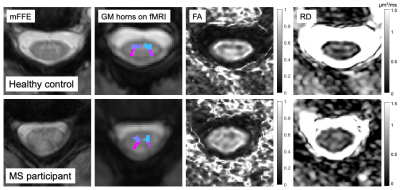 |
Increased Dorsal Network Functional Connectivity is Associated with DTI Indices in the Cervical Spinal Cord in Relapsing-Remitting MS
Anna JE Combes1,2, Kristin P O'Grady1,2, Baxter P Rogers1,2, Kurt G Schilling1,2, Richard D Lawless2,3, Mereze Visagie2, Delaney Houston2, Colin D McKnight1, Francesca R Bagnato4, John C Gore1,2,3,4, and Seth A Smith1,2,3
1Radiology & Radiological Sciences, Vanderbilt University Medical Center, Nashville, TN, United States, 2Vanderbilt University Institute of Imaging Science, Vanderbilt University Medical Center, Nashville, TN, United States, 3Biomedical Engineering, Vanderbilt University, Nashville, TN, United States, 4Neurology, Vanderbilt University Medical Center, Nashville, TN, United States
Tissue integrity and functional connectivity in the cervical spinal cord were assessed with diffusion tensor imaging and resting-state fMRI in a group of relapsing-remitting multiple sclerosis participants with low disability and healthy controls. Lower fractional anisotropy and higher radial diffusivity, markers of tissue damage, were associated with higher dorsal network connectivity in the patient group, but not in controls. These results suggest that increased connectivity may represent a compensatory mechanism in response to structural damage, in order to maintain relatively preserved clinical function in this group.
|
|||
3451.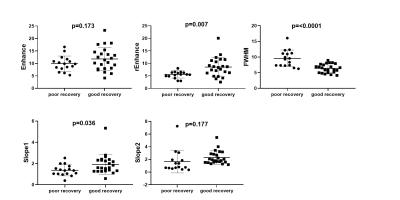 |
Preoperative Spinal Cord Perfusion has the ability to predict the postoperative prognosis for Patients with Cervical Spondylotic Myelopathy
Chunyao Wang1, Xiao Han2, Wen Jiang2, Guangqi Li1, Jinchao Wang2, Donghang Li2, Hua Guo1, and Huijun Chen1
1Center for Biomedical Imaging Research, School of Medicine, Tsinghua University, Beijing, China, 2Jishuitan hospital, Beijing, China
Cervical Spondylotic Myelopathy (CSM) is a chronic progressive disorder of spinal cord with a relatively ill-defined onset of pathogenesis. A series of state-of-art quantitative and functional MR imaging techniques has been proposed aiming to find out specific indicators in prediction and diagnosis of CSM at early phase, but lack of sufficient evidences. Spinal cord blood supply change was recognized as one of the crucial pathophysiological process in CSM. Thus, this study investigated the potential of pre-operative blood supply condition measured by DSC MRI with a non-parametric model in prediction of post-operative prognosis for patients with CSM.
|
|||
3452.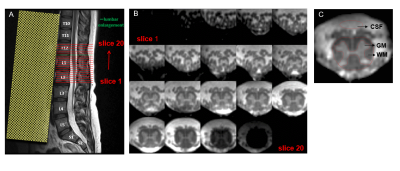 |
Analysis of signal and contrast in a multi-echo gradient-echo sequence of the lumbosacral cord: recommendations for number of echoes and averages
Silvan Büeler1, Patrick Freund2,3,4,5, Martina Liechti1, and Gergely David1,2
1Department of Neuro-Urology, Balgrist University Hospital, University of Zurich, Zurich, Switzerland, 2Spinal Cord Injury Center, Balgrist University Hospital Zurich, University of Zurich, Zurich, Switzerland, 3Department of Brain Repair and Rehabilitation, UCL Institute of Neurology, London, United Kingdom, 4Department of Neurophysics, , Max Planck Institute for Human Cognitive and Brain Sciences, Leipzig, Germany, 5Wellcome Trust Centre for Neuroimaging, UCL Institute of Neurology, London, United Kingdom
In this study, we aimed to provide recommendations on the number of echoes and averages when imaging the lumbosacral spinal cord using a multi-echo gradient-echo sequence. We found that while more echoes increase the white matter/cerebrospinal fluid contrast, the gray matter/white matter contrast plateaus at 3 echoes. Also, the signal and contrast-to-noise ratios increased only minimally after 6 averages. Overall, we recommend a minimum of 3 and maximum of 4 echoes as an optimal trade-off between segmentability and artifact level, and 6 signal averages (or measurements) for robust segmentations.
|
|||
3453.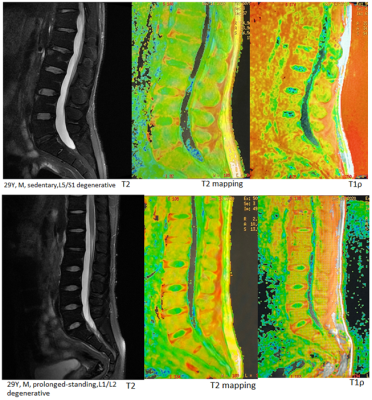 |
Lumbar disc degeneration changes in sedentary and prolonged-standing population assessed by T1ρ and T2 mapping Magnetic Resonance Imaging
Zeng qi1, Zhang ziwei1, Nie lisha2, Zhu xia1, Huang zaoshu1, and Song lingling1
1The affiliated hospital of Guizhou mdeical university, Guizhou guiyang, China, 2GE Healthcare,MR Resertch China, Beijing, China
Lumbar disc degeneration is an important cause of lower back pain, sedentary, prolonged-standing behavior accelerates its course. In this study we evaluate intervertebral disc degeneration quantified by T1ρ and T2 mapping magnetic resonance imaging in sedentary and long standing populations compared with a healthy control group matched for age. We conclude that prolonged-standing is more likely to affect the L1 / 2 level discs, while sedentary is more likely to affect the lower segment discs (L4 / 5 and L5/S1).
|
|||
3454.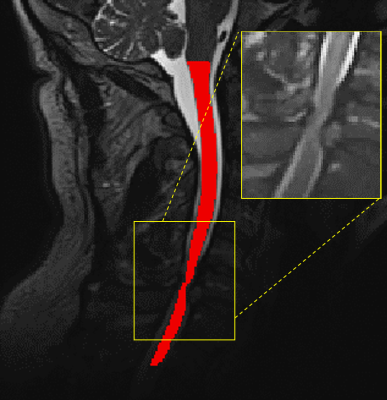 |
Spinal Cord Compression is Associated with Brain Plasticity in Degenerative Cervical Myelopathy
Alicia Cronin1,2, Sarah Detombe3, Camille Duggal2, Neil Duggal3, and Robert Bartha1,2
1Medical Biophysics, University of Western Ontario, London, ON, Canada, 2Centre for Functional and Metabolic Mapping, Robarts Research Institute, London, ON, Canada, 3Clinical Neurological Sciences, University Hospital, London Health Sciences Centre, London, ON, Canada
Degenerative cervical myelopathy (DCM) is one of the most common forms of spinal cord dysfunction. Predicting functional recovery after surgery remains elusive. The extent of cortical activation in the primary motor cortex was assessed using fMRI when DCM patients performed a controlled finger-tapping task. Spine compression severity was quantified using T2-weighted imaging. Patients with severe spine compression showed larger activation volumes. Recruitment of neurons to compensate for functional deficits may explain these activation changes. Hypoxia at the spine compression site may drive this cortical plasticity. Future studies should measure hypoxia and explore prognostic determinants.
|
|||
3455.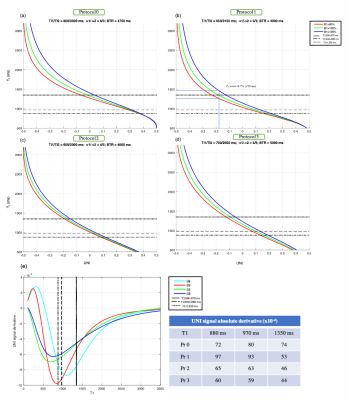 |
An optimized MP2RAGE sequence for studying both brain and cervical spinal cord
Arash Forodighasemabadi1,2,3,4, Henitsoa Rasoanandrianina1,2,3,4, Mohamed Mounir El Mendili1,2, Maxime Guye1,2, and Virginie Callot1,2,4
1Aix-Marseille Univ, CNRS, CRMBM, Marseille, France, 2APHM, Hopital Universitaire Timone, CEMEREM, Marseille, France, 3Aix-Marseille Univ, Université Gustave Eiffel, LBA, Marseille, France, 4iLab-Spine International Associated Laboratory, Montreal, Canada, Marseille, France
Magnetization Prepared 2 Rapid Acquisition Gradient Echo (MP2RAGE) is a T1 mapping technique used broadly on brain and recently on spinal cord (SC).The growing interest for combined investigation of brain and SC brings about the need for optimization with regards to spatial coverage, high CNR, low B1+ sensitivity, short acquisition time and high robustness.This work proposes an optimized sub-millimetric protocol for simultaneous brain and cervical spinal cord (BCSC) MP2RAGE acquisition at 3T and subsequent post-processing pipeline. It shows excellent agreement with previously proposed brain or SC protocols, with good reproducibility, which opens up great perspectives for clinical applications.
|
|||
3456.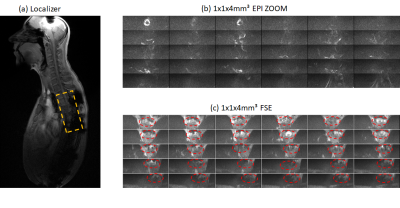 |
Single-Shot Inner-Field-of-View Fast Spin Echo Imaging with MAVRIC: Access to the Spinal Cord Close to Metallic Implants
Caspar Florin1 and Jürgen Finsterbusch1
11Department of Systems Neuroscience, University Medical Center Hamburg–Eppendorf, Hamburg, Germany
Inner field-of-view EPI provides a good image quality for diffusion-weighted imaging of the spinal cord in healthy subjects but suffers from severe artifacts in the vicinity of metallic implants that may be present in patients with traumatic injuries. Here, inner-field-of-view imaging based on cross-sectional RF pulses is used to obtain a single-shot fast spin echo technique that combined with multi acquisition variable-resonance imaging (MAVRIC) and view angle tilt (VAT) offers a more robust access to small target regions close to metallic implants and, thus, may be feasible for diffusion-weighted imaging of patients with traumatic spinal cord injury.
|
|||
3457.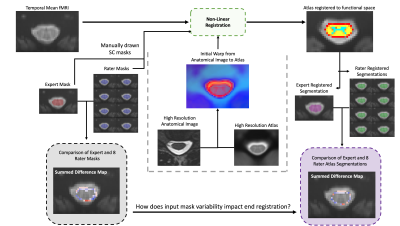 |
Impact of manual segmentation on the non-linear registration of a spinal cord atlas to functional space
Mark A Hoggarth1, Max C Wang2, Kimberly J Hemmerling1,2, Zachary A Smith3, Kenneth A Weber II4, and Molly G Bright1,2
1Physical Therapy and Human Movement Sciences, Northwestern University, Chicago, IL, United States, 2Biomedical Engineering, Northwestern University, Evanston, IL, United States, 3Neurosurgery, Oklahoma University, Oklahoma City, OK, United States, 4Anesthesiology, Perioperative and Pain Medicine, Stanford University, Palo Alto, CA, United States
Contouring the cervical spinal cord in functional MRI is a difficult but necessary task, that is typically performed manually. Differences between raters in drawing these masks could directly affect overall study results. This work compared the differences between spinal cord masks drawn by raters of varied experience with an expert rater on temporal mean fMRI images from 14 healthy participants; then the resultant warped atlas masks in functional space after non-linear registration using the Spinal Cord Toolbox. Performing non-linear registration increased overall agreement of the masks as a whole and along the edges where most disagreement occurs.
|
|||
3458.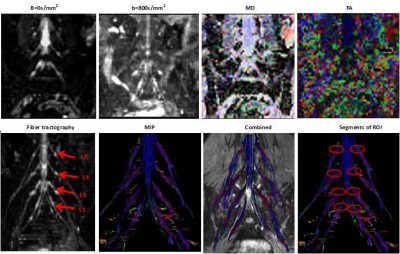 |
Quantitative Evaluation of Normal Lumbosacral Plexus Nerve Using Diffusion Tensor Imaging with Multiband SENSE
Nan Zhang1, Qingwei Song2, Ailian Liu2, Renwang Pu2, Haonan Zhang2, Jiazheng Wang3, and Liangjie Lin3
1The First Affilliated Hospital of Dalian Medical University, Dalian, China, 2The First Affiliated Hospital of Dalian Medical University, Dalian, China, 3Philips Healthcare, Beijing, China, Beijing, China
DTI can provide valuable structural information that may become an innovative tool in evaluating lumbosacral plexus nerve entrapment. Multiband SENSE technique could be used to accelerate the image acquisition .The present study aims to explore the feasibility of DTI with multiband SENSE on normal lumbosacral plexus nerve. The study showed that MB SENSE=2 was recommended for DTI on normal lumbosacral plexus nerve, which facilitated a xx% shorter image acquisition time than conventional SENSE accelerated diffusion tensor imaging.
|
|||
3459.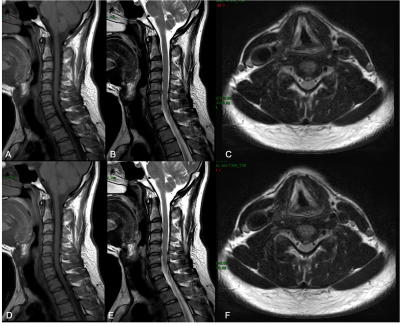 |
Clinical Feasibility Study of Accelerated 2D Magnetic Resonance Spinal Imaging Using Compressed Sensing Algorithm
Jianxing Qiu1, Jing Liu1, Qingping Gu2, Peng Sun2, and Naishan Qin1
1Peking University First Hospital, Beijing, China, 2Philips Healthcare, Beijing, China, Beijing, China
Compressed sensing algorithm (CS-MRI) could accelerate 3D MRI scanning time. In this study, we investigate the feasibility of CS-MRI in 2D spinal MRI. Totally 78 consecutive patients (29, 11 and 38 patients were examined by cervical vertebral, thoracic vertebral, thoracic vertebral MRI protocol respectively) were enrolled for both conventional MRI and CS-MRI. Both qualitative and quantitative analyses were conducted to compare the image quality and lesion diagnosis on conventional MRI and CS-MRI. And our results revealed that CS-MRI was valuable for improving the overall workflow of spinal MRI with scanning time saved and image quality improved.
|
|||
3460.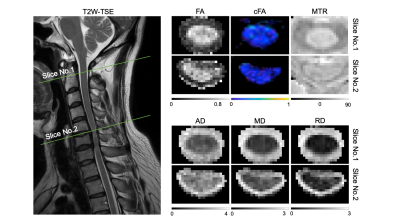 |
Multi-parameter model proposes a comprehensive imaging index for degenerative cervical myelopathy diagnosis: a preliminary study
Yuancheng Jiang1, Xiao Han2, Jinchao Wang2, Sisi Li3, Ke Wang4, Yandong Liu5, Wei Liang5, Wen Jiang5, and Hua Guo3
1Department of Biomedical Engineering, School of Medicine, Tsinghua University, Beijing, China, 2Department of spine surgery, Beijing Jishuitan Hospital, Beijing, China, 3Center for Biomedical Imaging Research, Department of Biomedical Engineering, School of Medicine, Tsinghua University, Beijing, China, 4Electrical Engineering and Computer Sciences, University of California, Berkeley, Berkeley, CA, United States, 5Department of Radiology, Beijing Jishuitan Hospital, Beijing, China
DTI and MTR have been reported to be useful in aiding the diagnosis of DCM. Some of the DTI and MTR metrics are significantly correlated with mJOA and thus can assist clinical assessment. However, previous studies have tended to only focus on a limited number of metrics. We aim to propose a comprehensive imaging index that correlates well with mJOA. It is based on the analysis of multiple metrics in different ROIs. In this preliminary study, we examine the correlation between mJOA and metrics at the C2 level. The plan and framework of the follow-up study are also presented.
|
The International Society for Magnetic Resonance in Medicine is accredited by the Accreditation Council for Continuing Medical Education to provide continuing medical education for physicians.